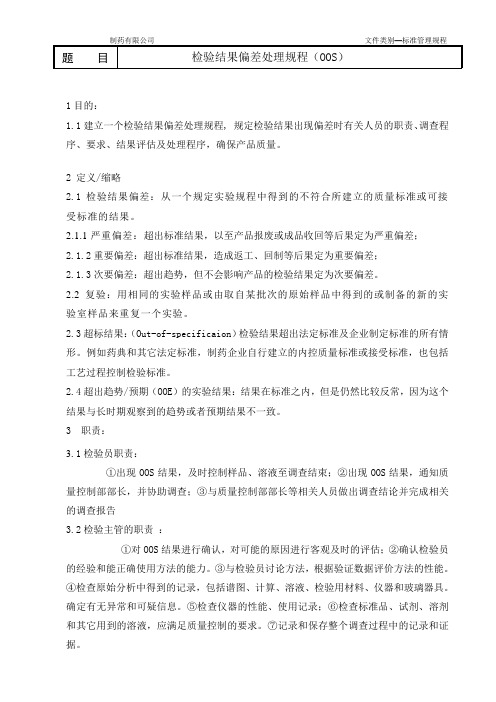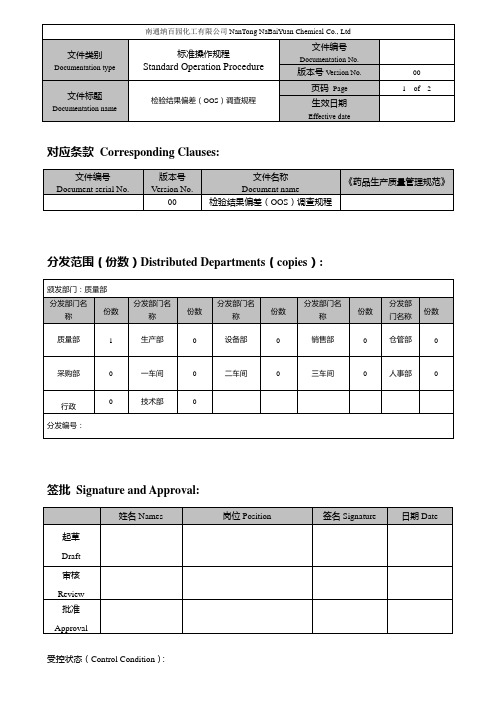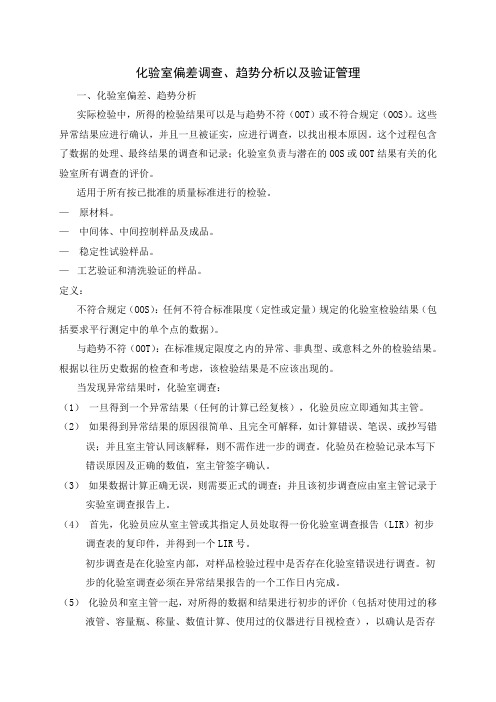偏差调查指南
偏差调查报告(批记录合规性检查)

偏差调查报告一、偏差描述2020年04月,质量管理部组织生产技术部相关人员以产品为导线,对工艺验证、工艺规程及批记录进行了自查,自查发现部分文件和批记录中存在少量问题,现将其共性问题罗列如下:二、应急处理措施1、对因人员操作产生的问题,立即进行培训、规范。
2、批记录审核时应关注上述问题,避免再次发生。
三、偏差风险评估1、对发现的问题相关人员采用头脑风暴法,进行风险评估。
评估发现多数问题对产品质量可控性、有效性、安全性无影响,或是对产品的质量产生较小的影响;有少数几个问题可能对产品质量或数据的完整性、记录的真实性产生影响,其详细评估如下:2、序号4问题:提取溶剂实际加入量与理论加入量有出入,经对在产17个品种核实,发现12品种存在此问题,祥见下表产生此情况的原因是:误认为计量方式精确度不能满足,对每罐的加入量进行了四舍五入修约。
如百部第一次加水量为17280L,平均分摊至四个提取罐,每罐为4320L,对其修约为4300L。
从上表数据可以看出,提取溶剂实际加入量与理论加入量差异并不大,6品种差值比例小于1%,1品种无差异,5产品差值大于1%。
提取溶剂量的不准确,可能对产品质量产生影响,因涉及产品工艺验证时均按此溶剂量进行验证,验证结果产品工艺和质量稳定,又因产品经过中间控制及成品检验,质量均符合标准规定,且通过对该产品年度质量回顾分析发现,产品工艺稳定、质量可靠,故对产品质量可控性的影响较小,风险等级为中。
3、序号14问题:批记录中部分数据无法溯源问题,是因批记录设计所致,通过查询相关辅助记录能证实有相关操作,但记录中未体现过程数据,数据统计时易产生差错,且违背了数据管理的相关原则,故其风险等级为中。
4、序号17问题:中药材净选时间较短,杂质量较少问题,主要原因为前处理人员编制较少,且我司集中生产,当日生产任务重,净选速度较快,耗时相对较少。
净选主要目的为拣选杂质、非药用部位等,对于岗位熟练操作人员能很快识别杂质,操作耗时较少,且因净选操作人员有时可能多余一人(复核人、工艺员、QA),但记录中只记录一人操作,再者因我司药材来货质量较优,杂质量较少,故在较短的时间内能将杂质挑出。
检验结果偏差处理规程

1目的:1.1建立一个检验结果偏差处理规程, 规定检验结果出现偏差时有关人员的职责、调查程序、要求、结果评估及处理程序,确保产品质量。
2 定义/缩略2.1检验结果偏差:从一个规定实验规程中得到的不符合所建立的质量标准或可接受标准的结果。
2.1.1严重偏差:超出标准结果,以至产品报废或成品收回等后果定为严重偏差;2.1.2重要偏差:超出标准结果,造成返工、回制等后果定为重要偏差;2.1.3次要偏差:超出趋势,但不会影响产品的检验结果定为次要偏差。
2.2复验:用相同的实验样品或由取自某批次的原始样品中得到的或制备的新的实验室样品来重复一个实验。
2.3超标结果:(Out-of-specificaion)检验结果超出法定标准及企业制定标准的所有情形。
例如药典和其它法定标准,制药企业自行建立的内控质量标准或接受标准,也包括工艺过程控制检验标准。
2.4超出趋势/预期(OOE)的实验结果:结果在标准之内,但是仍然比较反常,因为这个结果与长时期观察到的趋势或者预期结果不一致。
3 职责:3.1检验员职责:①出现OOS结果,及时控制样品、溶液至调查结束;②出现OOS结果,通知质量控制部部长,并协助调查;③与质量控制部部长等相关人员做出调查结论并完成相关的调查报告3.2检验主管的职责:①对OOS结果进行确认,对可能的原因进行客观及时的评估;②确认检验员的经验和能正确使用方法的能力。
③与检验员讨论方法,根据验证数据评价方法的性能。
④检查原始分析中得到的记录,包括谱图、计算、溶液、检验用材料、仪器和玻璃器具。
确定有无异常和可疑信息。
⑤检查仪器的性能、使用记录;⑥检查标准品、试剂、溶剂和其它用到的溶液,应满足质量控制的要求。
⑦记录和保存整个调查过程中的记录和证据。
3.3质量控制部部长的职责:①指导化验室进行不合格结果的调查,并对调查过程及相关记录进行检查。
②决定是否进行化验室调查,如需要调查,则要组织、参与调查过程,并协助QA的全面调查。
15 偏差分析、调查、处理管理制度

1.目的建立偏差分析、调查、处理程序。
2.适用范围适用于偏差的处理。
3.术语定义无4.职责生产部人员、质量部人员。
5.流程图无6.内容及方法6.1内容6.1.1在实际生产,检验的过程中如果出现严重偏离正常值的情况时,应进行偏差分析。
6.1.2.遇到以下偏差之一必须及时处理(1)物料平衡超出收率的正常范围;(2)生产过程时间控制超出工艺规定范围;(3)生产过程工艺条件发生偏移,变化;(4)生产过程中设备突然异常,可能影响产品质量;(5)跑料;(6)产品质量(含量、外观、工序加工)发生偏移;(7)标签实用数、剩余数、残损数之和与领用数发生偏差;(8)生产检验中的其他异常情况。
6.2偏差处理程序6.2.1发生超限偏差时,须填写偏差处理单,写明品名、批号、规格、数量、工序、偏差内容、发生的过程及原因、地点、填表人、日期。
将偏差处理单交生产部负责人;6.2.2生产部负责人会同相关人员进行调查,根据调查结果提出处理意见;6.2.3生产部人员就上述处理意见,写出偏差调查处理报告(一式两份),生产部负责人签字后连同偏差处理单报质量部,由质量部会同生产部负责人进行审核,批准。
6.2.4生产部门按照批准的文件组织实施;同时将偏差处理单、偏差调查处理报告归档保存备查。
6.2.5发现偏差批次与该批前后批次产品有关联时,必须立即通知质量部门,作出相应处理。
6.2.6出现分析偏差时,应按照《实验室异常结果处理制度》操作。
6.2.7束后,应实施在线监控,以确认该偏差以得到圆满解决。
7.相关文件无8.记录8.1 《偏差调查处理报告》 KE-QP-RE-123-*8.2 《偏差处理台账》 KE-QP-RE-124-*9.附件无。
偏差调查管理程序

1 目的建立偏差处理操作规程,为偏差的处理提供规范的程序,使所有的偏差得到有效的调查和评估。
2 范围适用于任何偏离预定的生产工艺、物料平衡限度、质量标准、检验方法、操作规程等情况的偏差。
3职责3.1 偏差发现人/ 部门:发现偏差后立即如实报告偏差,采取应急处理措施。
协助调查偏差原因,分析和汇总调查信息,提出建议并记录。
执行纠正及预防措施的实施。
3.2 偏差涉及的相关部门:积极协助调查偏差的原因,提出处理意见及纠正预防措施,防止再次发生类似偏差。
并提供相应的书面支持文件。
3.3 质量保证部:负责偏差的分类;对重大偏差负责组织相关部门进行彻底调查,并有调查报告;负责向质量受权人通报偏差及其处理情况;保存偏差调查、处理的文件及记录。
3.4 质量控制部:发生重大偏差时需对产品进行额外的检验来评估其对产品质量的潜在影响,必要时,应对涉及重大偏差的产品进行稳定性考察。
3.5 质量负责人/ 质量受权人:对偏差处理负有监督责任;了解掌握偏差及其处理情况,对产品放行与否做出决定。
4 定义4.1 偏差:指偏离已批准的程序(指导文件)或标准的任何情况,包括任何偏离生产工艺、物料平衡限度、质量标准、检验方法、操作规程等情况,凡是与现行标准规定的技术参数、质量参数、数量参数、设备操作参数、计量标准等发生偏离的情况及生产过程中不可预计的突发异常情况,如停电、停水等,都称为偏差。
5 程序5.1 偏差的分级5.1.1 次要偏差:不会影响产品质量的偏差。
5.1.2 重大偏差:对产品质量造成影响,或不能确认对产品质量是否造成影响的偏差。
5.2 偏差的种类(举例)5.2.1 生产过程中可能出现的偏差:生产过程中工艺条件发生偏移、变化;生产过程时间超出工艺规定的允许范围;物料平衡超出合格的范围;生产过程中设备突然异常,可能影响产品质量;产品质量(外观、含量等)发生偏移;跑料;包装材料领用数与实用数、剩余数及残损数之和发生偏差;生产过程中所有超出批准的指令和既定的标准的情况。
7偏差调查、根源分析及报告

分类:
次要偏差:没有影响产品安全、浓度、纯度、特性及没
有表现为重大的不符合法规风险的偏差。
主要偏差:那些涉及如上因素的偏差。
严重偏差:同“主要偏差”的外加影响产品放行到市场
的偏差。
“质量金字塔”
法规行动 召回/市场行动 偏 隐 差 患
偏差系统与其它系统相关
验证系统 变更控制
批放行 偏差系统 整改预防措施(CAPA) 符合法规 年度产品回顾
如何撰写偏差调查报告?
4.结论:
根源状态 缺陷概述 系统影响
5.整改及预防措施(CAPA)
整改及补救行动 预防措施
跟踪及趋势
6.附件 7.参考资料
撰写偏差调查报告应注意„
消除常见的错误:
• 未解决问题:如:提及OOS是片剂的硬度事件, 但没有对片子的硬度进行评估。
• 夸大:如:“这是一宗严重的偏差” • 列举无关的数据:如:列出硬度偏差的批次数
偏差调查、根源分析及报告
2010年06月 阿特维斯(佛山)制药有限公司 劳卡
如何进行根源分析?
如何撰写偏差调查报告?
偏差的定义及分类
定义:偏差是指对标准的程序、指令或建立的标准的偏
离。是指非计划的、不符合已建立的SOP、主批记录、法 律法规文件、验证体系和测试方法、规格或其他标准的事 件,该事件可能影响产品或生产物料的质量、纯度、特性、 浓度及安全性或其重要属性。
尽可能收集更多的信息
• 研究问题
• 关注数据
硬数据:事实、结果、可测量项目
软数据:感觉、意见
• 使用好的工具
自由讨论、柱状图、检查表、因果图、 5Why、FMEA等等
举
事件描述:
偏差调查指南

偏差调查指南偏差调查指南Guideline for Deviation Investigation●问题陈述Define the problem为执行结构性地根本原因分析,可通过清楚地描述问题来理解这个偏差。
偏差描述应包括充足的信息,以便能被理解;应清晰简洁、可量化且记录事件的重要性。
调查过程中随着获取更多的信息,偏差描述可被修改(如适用)。
In order to perform a structured root cause analysis the problem needs to be understood,this is achieved by creating a problem statement for the deviation.This statement describes the problem with enough information to ensure the deviation is understood.The statement shall be clear and concise,be quantifiable and should document the magnitude of the event.The problem statement may be amended,if appropriate,during the course of the investigation as more information becomes available.●建立时间表Establish Timeline见如下“缺失事件表”。
Refer to Loss Event Timeline as below.●收集数据Collect the data描述应发生什么Map what should have occurred为启动调查,应收集关于如何操作工艺的信息。
这些信息应包括所有相关的文件和知识,如:生产和包装指令、标准操作规程、工作工艺流程和可用的工艺或产品开发知识。
有效的偏差调查和纠偏预防体系

案例三:人员偏差调查与纠偏
总结词
人员偏差调查与纠偏是提升员工操作技 能和工作态度的重要途径
VS
详细描述
员工的操作技能和工作态度对生产过程中 的偏差产生具有重要影响。通过定期对员 工进行操作技能和工作态度的评估,及时 发现偏差并进行调查,采取相应的纠偏措 施进行培训或指导,可以有效提升员工的 操作技能和工作态度,降低生产过程中的 偏差产生。
通过定期进行环境监测、加强环境控 制设备的维护和保养,以及推行清洁 生产和环保政策等措施,确保生产环 境的符合性。同时,建立环境管理体 系、加强环境意识和培训等措施,提 高员工的环境意识和参与度,降低环 境问题发生的可能性。
04
偏差调查和纠偏预防体系的应用案例
案例一:工艺偏差调查与纠偏
总结词
工艺偏差调查与纠偏是确保产品质量的关键环节
未来发展方向和挑战
智能化技术的应用
随着人工智能、大数据等技术的发展,未来偏差调查和纠 偏预防体系将更加智能化,提高调查和纠偏的效率和准确 性。
数据安全与隐私保护
在收集和分析生产数据的过程中,如何确保数据的安全性 和隐私保护,防止数据泄露和滥用,也是未来需要关注的 问题。
跨部门协同
随着企业规模的不断扩大和组织结构的复杂化,如何实现 跨部门之间的有效协同,共同推进偏差调查和纠偏预防体 系的实施,将是一个重要挑战。
偏差调查的流程和方法
流程
偏差调查通常包括识别偏差、收集数据、分析原因、制定纠正措施和验证纠正效 果等步骤。
方法
常用的偏差调查方法包括鱼骨图、因果图、5W1H分析法、头脑风暴法等,可根 据具体情况选择合适的方法。
02
偏差原因分析
工艺偏差原因
工艺流程设计不合理
偏差调查-吴军

培养基 污染
27
环境条件
北京齐力佳
28
北京齐力佳
无菌检查试验结果阳性的常规调查程序(1)
实验室调查
分离并鉴别污染菌 审查检验过程及记录 审查无菌检验环境监测资料 回顾灭菌前半成品(或过滤前药液)的含菌量 审查无菌检验历史记录
29
北京齐力佳
无菌检查试验结果阳性的常规调查程序(2)
需要信息 信息来源 查资料 现场核对 提问:5W,即5个为什么 ? 数理统计 :定性 确认 ;数据 量化。
收集数据
2、 构建设想
假设推理 排列设想 选择假设
分析结果
4 识别根本原因
25
北京齐力佳
偏差调查的信息来源与问题根源
调查的信息来源
问题的根源:
生产过程控制标准
8
北京齐力佳
偏差的类型
与生产条件有关的偏差:与设定的生产条件不相符的 偏差
水、电、气(汽)的正常供应 设备的正常运行 计量器具的校验 环境控制结果 安全与环境方面条件
9
北京齐力佳
偏差处理的原则
任何人员必须按照已经批准的文件进行管理和操作。 出现偏差必须立即报告并按偏差处理的程序进行。 严禁隐瞒不报偏差及产生原因或未经批准私自进行偏 差处理的情况。
32
北京齐力佳
无菌灌封生产关键表面监测中检出微生物的调查(2)
调查结论
结论的一种可能:无菌保证与无菌保护系统没有缺陷,单个微生物的检 出有可能来自于监测过程。
偏差调查5why法

偏差调查5why法
偏差调查5why法是一种用于解决问题的系统性方法,通过连续追问“为什么”
来深入分析问题的根本原因。
这种方法最初由丰田汽车公司引入,后来被广泛应用于各个行业,以帮助组织识别和消除问题,从而改善业务流程和提高效率。
在偏差调查中使用5why法的过程是逐步的,首先确定一个特定的问题或偏差,然后反复追问“为什么”这个问题发生,直到找到根本原因。
通常,需要进行至少5
次追问才能找到问题的真正根源,因此得名5why法。
通过5why法,组织可以深入了解问题的本质,而不仅仅是应对表面症状。
这
种方法有助于避免仓促做出决策,提高问题解决的效率和彻底性。
同时,通过识别问题的真正原因,组织可以采取有针对性的措施来解决问题,避免问题的再次发生。
在实施5why法时,有几个注意事项需要注意。
首先,要确保问题的描述清晰
明了,问题不应该含糊不清或过于宽泛,以便更好地进行追问。
其次,每个“为什么”问题都应该有一个明确的答案,避免模糊不清或主观猜测。
最后,要确保在追
问过程中能够充分挖掘出问题的根本原因,而不是停留在表面问题上。
总的来说,偏差调查5why法是一种简单而有效的问题解决方法,可以帮助组
织深入了解问题的本质,找到问题的根本原因,从而采取有效的措施来解决问题。
通过不断实践和应用,组织可以不断提升问题解决的能力,提高运营效率,提升绩效表现。
因此,值得各个组织在日常工作中积极采用这种方法,不断改进和提升自身的竞争力。
归因偏差调研报告

归因偏差调研报告一、调研目的本次调研的目的是研究归因偏差的现象,并探索其对个体决策和行为的影响。
通过了解归因偏差的机制和原因,可以为个体提供更准确的认知,并在决策过程中减少错误的归因偏差。
二、调研方法本次调研采用问卷调查的方式,针对100名大学生进行了调查。
问卷包括两部分内容:一是调查个体在特定情境下的归因偏差情况,二是调查个体的决策和行为。
三、调研结果1.归因偏差情况调查结果显示,73%的被调查者在特定情境下存在归因偏差的现象。
其中,51%的被调查者存在自我归因偏差,即将自己的成功归因于内因,将失败归因于外因。
另外,22%的被调查者存在他人归因偏差,即将他人的成功归因于外因,将他人的失败归因于内因。
这表明归因偏差现象在大学生群体中比较普遍。
2.归因偏差的影响调查结果显示,归因偏差会对个体的决策和行为产生一定的影响。
被调查者在自我归因偏差的情况下,更容易高估自己的能力和过度自信,同时更容易低估外部因素的影响和其他人的贡献。
而在他人归因偏差的情况下,被调查者更容易排除其他人的努力和能力,过度赞赏自己,从而导致合作和协作的困难。
这些现象进一步说明了归因偏差对个体决策和行为的影响。
四、调研讨论1.归因偏差机制归因偏差的机制主要与个体的自我保护心理、自我肯定感和认知限制有关。
个体倾向于通过将成功归因于内因,来增强自己的自尊和信心,同时将失败归因于外因,以保护自己的自尊和避免责任。
此外,个体对于复杂事物的认知有限,往往更容易将归因简化为个别因素,从而导致归因偏差的出现。
2.归因偏差的减少为了减少归因偏差的出现,个体可以通过一些策略来提高自身的认知。
首先,个体可以关注更多的信息和证据,以减少对内因或外因的过度归因。
其次,个体可以进行自我反思和自我评估,以提高对自己能力的客观认知。
此外,个体可以增强对于他人和自己行为的理解,以减少对归因的偏见。
五、结论本次调研发现归因偏差在大学生中比较普遍,并对个体的决策和行为产生了一定的影响。
偏差调查ppt课件

21CFR Subpart J: 记载;
211.192 部分生产记录参考。 211.180(f)部分总需求。
211.180(b)(12)部分批生产和控制记录。
211.198(a)部分投诉文件。
6
北京齐力佳
偏差处理的范围
该政策适用于下列方面:
在生产,转运,取样,储存或上市产品的检验,原材料或组分等方 面产生的任何不符合性。 影响到设施,设备,过程,用于生产及检验系统和程序等方面的任 何不符合性。 不可接受的产品的缺陷是显著的且必须以不符合性报告来记录。
10
北京齐力佳
案例1
2006年3月10日,在生产200203301批时,在配制 工序发现,在称取氯化钠时,天平程序故障,用砝码 校正时发现称量到800克时,天平出现较大的误差, 随后采用分二次称取的方法称量,但发现物料出现短 少,发放量少于投料量。
11
北京齐力佳
案例3
2005年3月17日,某制药企业在生产一批小容量注射 剂200203306批时,QC检验稀释液最后的PH值为 7.04,但灌封后灭菌柜灭出第一锅成品,经QC抽样检 测灭菌后灌封后的PH值为6.55,经研究决定在中配罐 里加NaOH调节PH值,后测灌封的产品PH为6.8。
人员/实施
文件/记录
产品/物料
15
北京齐力佳
偏差的类型:检验偏差
超标准跟踪结果(OOS)
任何单个值不符合已建立的法定的可接受标准,草案,检验方 法或程序。
校验与维护
当发现实验室的仪器超出可接受的校验限或出现故障应实行 不符合性的调查.仪器在待定维修和重新确认维修完成后完成 不符合性的报告。
偏差调查管理程序

偏差调查管理程序1目的建立偏差处理操作规程,为偏差的处理提供规范的程序,使所有的偏差得到有效的调查和评估。
2范围适用于任何偏离预定的生产工艺、物料平衡限度、质量标准、检验方法、操作规程等情况的偏差。
3职责3.1偏差发现人/部门:发现偏差后立即如实报告偏差,采取应急处理措施。
协助调查偏差原因,分析和汇总调查信息,提出建议并记录。
执行纠正及预防措施的实施。
3.2偏差涉及的相关部门:积极协助调查偏差的原因,提出处理意见及纠正预防措施,防止再次发生类似偏差。
并提供相应的书面支持文件。
3.3质量保证部:负责偏差的分类;对重大偏差负责组织相关部门进行彻底调查,并有调查报告;负责向质量受权人通报偏差及其处理情况;保存偏差调查、处理的文件及记录。
3.4质量控制部:发生重大偏差时需对产品进行额外的检验来评估其对产品质量的潜在影响,必要时,应对涉及重大偏差的产品进行稳定性考察。
3.5质量负责人/质量受权人:对偏差处理负有监督责任;了解掌握偏差及其处理情况,对产品放行与否做出决定。
4 定义4.1 偏差:指偏离已批准的程序(指导文件)或标准的任何情况,包括任何偏离生产工艺、物料平衡限度、质量标准、检验方法、操作规程等情况,凡是与现行标准规定的技术参数、质量参数、数量参数、设备操作参数、计量标准等发生偏离的情况及生产过程中不可预计5程序5.1 偏差的分级5.1.1次要偏差:不会影响产品质量的偏差。
5.1.2重大偏差:对产品质量造成影响,或不能确认对产品质量是否造成影响的偏差。
5.2偏差的种类(举例)5.2.1生产过程中可能出现的偏差:生产过程中工艺条件发生偏移、变化;生产过程时间超出工艺规定的允许范围;物料平衡超出合格的范围;生产过程中设备突然异常,可能影响产品质量;产品质量(外观、含量等)发生偏移;跑料;包装材料领用数与实用数、剩余数及残损数之和发生偏差;生产过程中所有超出批准的指令和既定的标准的情况。
5.2.2检验结果超标:QC在检验中发现中间体、成品检验结果超出标准。
偏差调查与处理管理规程

1.目的明确和规范偏差调查处理程序,确保任何与产品质量有关的偏差得到有效的调查和评估,确保所有发现的偏差都得到报告、记录、调查、处理和批准并采取及时有效的纠正和预防措施,保证产品质量的安全性、有效性以及质量的可控性,防止类似偏差再次发生。
2.范围适用于公司生产、检验、管理等全过程中发生的任何与产品质量相关的偏差。
3.职责3.1.偏差发生部门:负责及时、如实报告偏差;采取应急处理措施;协助调查偏差的原因;执行纠正及预防措施的实施。
3.2.偏差相关部门:配合调查偏差的原因,提出处理意见及纠正预防措施,并提供相应的书面支持文件。
3.3.偏差调查小组:由偏差相关部门专业人员组成,负责对发生的偏差进行全面及时的调查;负责整理收集有关文件及记录,并对偏差进行调查和分析。
3.4.偏差评审小组:负责偏差所涉及的物料或过程的质量风险评估、处置建议以及相应的纠正预防措施,由以下部门负责人及相关专业人员组成:质保部、生产部、技术部、采购部、物资部。
3.5.质保经理:负责偏查风险等级的评估并确定其所涉及的相关部门;负责组织人员调查偏差产生原因;负责对偏差进行审核、批准、评估及跟踪;负责对次要/主要缺陷等级的偏差处理的终审;3.6.管理层:由技术副总、常务副总、总经理组成。
确保需要立即采取的措施完成,为调查及措施跟踪提供足够、合格的资源;负责对关键缺陷等级的偏差处理的终审。
4.规程4.1.定义4.1.1.偏差:是指与已经批准的和产品质量相关的标准、规定、条件、安全、环境等不相符的情况,它包括生产全过程和各种相关的影响因素。
如:产品检验/环境检测/校验等超标、过程控制缺陷/工艺参数漂移、物料平衡超限、混淆/污染/人为差错、产品/物料储存异常、设备故障、客户投诉、违反法规要求、与已批准的标准/程序/指令不相符等偏差事件。
4.1.2.偏差调查与处理:是指当发生上述偏差时,对偏差产生的原因进行调查,偏差对产品质量的影响程度进行分析,纠正和防止偏差再发生的措施等进行处理的程序。
偏差调查报告

偏差调查报告
偏差编号:偏差分类□重要偏差□次要偏差
1.偏差描述
1、2 即时采取得措施
1、1基本信息:
发生日期: 报告部门:
受影响产品与规格/设备/系统:
产品批号: 数量:有效期:
该偏差可能涉及得其她产品:
原因
原辅材料注释:
停止产品生产注释:
取样与送检
1、3 备注
报告人签名:
报告日期(2个工作日内):
偏差编号: 2、偏差调查
2、1调查及分析原因:
2、2纠偏措施
调查人签名
日期
批准人签名(相关部门经理与QA经理)
日期
偏差编号: 3、 QA评估
3、1评估(基本原因/决定)
偏差影响评估:有无注释
产品质量/安全性/功能
同产品其她批次
其她产品
其她系统
其她
签名日期
3、2 结论及批准
批号及数量:
备注:
签名(QA经理) 日期
4、分发ﻩ
偏差调查分发给以下部门:□生产部门
□技术部门
5.后续跟踪。
检验结果偏差(OOS)调查规程

对应条款Corresponding Clauses:分发范围(份数)Distributed Departments(copies):签批Signature and Approval:目的:确定化验数据不符合要求或化验结果不符合质量标准的调查程序。
范围:原辅料、稳定性样品、成品、中间体检验操作及计算过程以及由此追溯到对生产过程的调查。
职责:QC人员、QC主管、QA人员、QA主管、质量部经理。
引用文件:规程:1定义1.1 复测:取已测定的同样留样另一部分进行重新测定。
1.1 再检验:取已测定的同样的样品溶液使用同样的试剂和标准品进行再测定。
1.2 再取样:经批准有原因地重新按要求抽样。
2程序正文2.1 当QC人员在检验样品时,发现操作过程不当(如样品泼洒、定量过量等)、仪器故障应立即停止实验,须重新开始实验。
不必进行实验偏差调查。
2.2QC人员发现检测数据不符合要求或检验结果不符合质量标准时,应立即报告QC主管并填写检验调查申请单,填写的内容为产品名称、批号、问题描述、检验人四项内容,交QC主管。
2.3 同时该QC人员将所测定的原样品溶液以及使用的其它标准品试剂及其它溶液保留(除非样品极不稳定)直到调查完成。
如有必要应控制贮存条件,如常温不稳定应置冰箱保存。
QC主管立即和QC人员一起按化验调查报告检查清单的内容进行调查,并由QC主管决定再检验及复测,按2.8中的规定进行复测和再检验。
完成后填写化验调查报告,交质量部经理批准。
2.5 在进行上述调查的同时或根据以上调查不能确认QC检验问题的,由QA进行初步生产过程的调查,采取再抽样等措施并记录于原始记录中。
2.6如系QC人员分析方面的问题:化验员不懂操作应进行培训,责任心不强应进行行政处罚;如不是化验问题应对生产进行调查。
2.7对于不合格的原辅料、按不合格原辅料处理;成品和中间体填写偏差报告交QC主管,由QA主管安排进一步生产过程调查。
2.8 复测/再检验和再抽样2.8.1 如找不到具体有说服力的原因应由另外QC人员同时进行复测和再检验(样品极不稳定不必进行再检验)。
化验室偏差调查

化验室偏差调查、趋势分析以及验证管理一、化验室偏差、趋势分析实际检验中,所得的检验结果可以是与趋势不符(OOT)或不符合规定(OOS)。
这些异常结果应进行确认,并且一旦被证实,应进行调查,以找出根本原因。
这个过程包含了数据的处理、最终结果的调查和记录;化验室负责与潜在的OOS或OOT结果有关的化验室所有调查的评价。
适用于所有按已批准的质量标准进行的检验。
—原材料。
—中间体、中间控制样品及成品。
—稳定性试验样品。
—工艺验证和清洗验证的样品。
定义:不符合规定(OOS):任何不符合标准限度(定性或定量)规定的化验室检验结果(包括要求平行测定中的单个点的数据)。
与趋势不符(OOT):在标准规定限度之内的异常、非典型、或意料之外的检验结果。
根据以往历史数据的检查和考虑,该检验结果是不应该出现的。
当发现异常结果时,化验室调查:(1)一旦得到一个异常结果(任何的计算已经复核),化验员应立即通知其主管。
(2)如果得到异常结果的原因很简单、且完全可解释,如计算错误、笔误、或抄写错误;并且室主管认同该解释,则不需作进一步的调查。
化验员在检验记录本写下错误原因及正确的数值,室主管签字确认。
(3)如果数据计算正确无误,则需要正式的调查;并且该初步调查应由室主管记录于实验室调查报告上。
(4)首先,化验员应从室主管或其指定人员处取得一份化验室调查报告(LIR)初步调查表的复印件,并得到一个LIR号。
初步调查是在化验室内部,对样品检验过程中是否存在化验室错误进行调查。
初步的化验室调查必须在异常结果报告的一个工作日内完成。
(5)化验员和室主管一起,对所得的数据和结果进行初步的评价(包括对使用过的移液管、容量瓶、称量、数值计算、使用过的仪器进行目视检查),以确认是否存在任何可确认的化验室错误(已知的化验室错误)或笔误。
在进行该阶段调查的同时,完成LIR最初调查表。
注:a)化验员和室主管可以利用附件4所给出的检查清单(化验员/主管化验室初步调查检查帮助清单),以帮助进行初步调查调查范围:常规项目:化验员的培训;检验操作;计算;试剂;标准品;环境;仪器;仪器性能;过滤器;容量瓶;震荡器;仪器校验;使用的天平;移液管。
- 1、下载文档前请自行甄别文档内容的完整性,平台不提供额外的编辑、内容补充、找答案等附加服务。
- 2、"仅部分预览"的文档,不可在线预览部分如存在完整性等问题,可反馈申请退款(可完整预览的文档不适用该条件!)。
- 3、如文档侵犯您的权益,请联系客服反馈,我们会尽快为您处理(人工客服工作时间:9:00-18:30)。
偏差调查指南Guideline for Deviation Investigation●问题陈述Define the problem为执行结构性地根本原因分析,可通过清楚地描述问题来理解这个偏差。
偏差描述应包括充足的信息,以便能被理解;应清晰简洁、可量化且记录事件的重要性。
调查过程中随着获取更多的信息,偏差描述可被修改(如适用)。
In order to perform a structured root cause analysis the problem needs to be understood,this is achieved by creating a problem statement for the deviation.This statement describes the problem with enough information to ensure the deviation is understood.The statement shall be clear and concise,be quantifiable and should document the magnitude of the event.The problem statement may be amended,if appropriate,during the course of the investigation as more information becomes available.●建立时间表Establish Timeline见如下“缺失事件表”。
Refer to Loss Event Timeline as below.●收集数据Collect the data描述应发生什么Map what should have occurred为启动调查,应收集关于如何操作工艺的信息。
这些信息应包括所有相关的文件和知识,如:生产和包装指令、标准操作规程、工作工艺流程和可用的工艺或产品开发知识。
To initiate the investigation,information shall be collected about how the process should have been rmation shall include all relevant documentation and knowledge e.g.manufacturing and Packaging instructions,Standard Operating Procedures,work and process flows,and available process or product development knowledge.描述实际发生了什么Map what actually Happened分别收集和分析所有工序记录、工艺控制结果和环境数据及重现实际操作。
这些应通过可视化管理和人员面谈进行核对。
收集的信息应确保任何变化和异常都能被发现。
调查组需对实际发生的事件及其顺序达成一致。
Separately collect and analyze all process records,process control results and environmental data together and recreate the process actually performed.This shall be verified by GEMBA and operator Interviews.The information shall be collected in such a manner that any changes or differences can easily be identified.An agreement within the team must be reached about what should have occurred and the sequence of actual events. MMEEPPS分类(与物料、方法、设备、环境、人员、工艺和系统)可用于数据收集。
相关的影响因素(不完全)罗列如下,供参考。
The MMEEPPS categories can also be used to collect data.These relate to Materials,Methods,Equipment, Environment,People,Process Design and Systems.The factors listed below are for consideration.可使用一些方法收集工艺和事件的数据,包括但不限于:缺失事件表,故障树分析,否认模型,5个为什么,是或否,鱼骨图/因果关系,失效模式与影响分析。
There are a number of techniques that can be used to collect data on the process and the event that occurred these include,but are not limited to:Loss EventTimeline,Fault Tree Analysis,Contradiction Matrix,5Whys,Is/Is Not,Fishbone diagram/Cause and Effect,FMEA.●分析差距Gap Analysis就上述收集的工艺设计和实际操作进行差距分析,识别并记录期望和实际工艺之间的任何变化和不同。
调查组应就识别的差距达成一致。
差距识别后可回顾和修改问题描述(这一步骤应在潜在原因识别前完成)。
Conduct a gap analysis of the process as designed and the process as operated.Identify and record anypoints where there is a change or difference between the expected and actual processes.An agreementwithin the team shall be reached that all gaps have been identified.Review and Revise the problemstatement based on the identified Gaps(this step must be complete prior to the step of identification ofpotential causes.●识别潜在原因Identification of Potential Causes上一步骤识别的差距应按偏差的潜在原因处理。
Each gap identified above shall be treated as a potential cause of the problem.o应考虑其它的可能原因,可使用头脑风暴(如:鱼骨图分析)Other possible causes shall also be considered,these can be derived from a brainstorming process,such as a Fishbone analysis.o基于识别的其它潜在原因,回顾和修改问题描述Review and Revise the problem statement based on the other identified potential causes.o应评估每个差距或识别的其它可能原因对调查问题的潜在影响,发挥调查组员的专业知进行严重性或影响分类Each gap or identified other possible cause shall be assessed for its potential impact on the problem under investigation,and using the available expertise within theinvestigation team,ranked for importance or Impact.o调查组应就可能原因的等级排序达成一致An agreement within the team shall be reached on the ranked order of the possible causeso该步骤识别的差距或其他可能原因的理由应被记录The reason for any identified gap or other possible cause that is discounted at this stage shall be recorded●确定根本原因Root Cause Determination应使用合适的工具回顾每个可能原因,识别偏差的根本原因和促成因素。
Each of the ranked likely causes shall be reviewed using appropriate tools to identify the Root Cause of the problem,and other contributory causes.o当不能识别根本原因时各个可能原因应按根本原因解决Where it is not possible to identify Root Cause each probable cause shall be treated as if it were a root cause.如根本原因或促成因素被识别为人员因素,应进一步评估识别更深层次的问题Where the root cause orother contributory causes identify Human Factors,these shall be further evaluated to identify the underlying issues.识别的原因应评估是否可以完全解决问题,对于复杂问题可能需要一系列实验进行确认Theidentified causes shall be evaluated against the problem statement to confirm that they completely explain the problem.In complex cases this may require a series of trials or experiments to confirm.o如可能原因被忽略应记录忽略原因并关联到根本原因调查报告中Where a likely cause has been discounted this shall be recorded and justified and referenced in the root cause investigation report.o调查组应对忽略可能原因的决定达成一致There shall be consensus in the investigation team regarding any decision to discount a likely cause.o应准备每个步骤的调查总结,应详述问题陈述、简要描述、工艺步骤、使用的工具和作出的决定A summary report of the investigation that details the problem statement and briefly describes,the steps of the process,tools used and decisions made at each step shall be prepared.o调查报告应遵循正确书写的原则并可提交给法规部门,报告应包括:The report needs to be constructed with the principle of Write right,and be suitable for submission to a regulatory or government authority.The report shall contain:确定根本原因和最可能原因The Root or most probable causes determined识别促成因素Contributory causes Identified忽略可能原因的解释Justification for any potential causes being discounted制定CAPA Definition of CAPA基于根本原因或可能的根本原因及已完成的调查,调查组长或调查团队提出有效的纠正与预防措施来解决偏差,减轻影响或能理想地解决问题。
